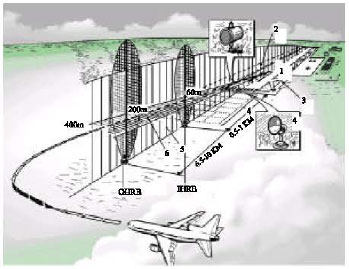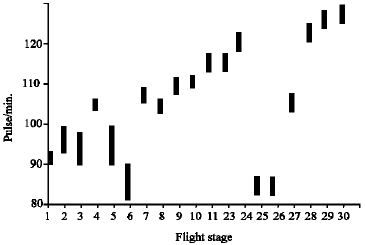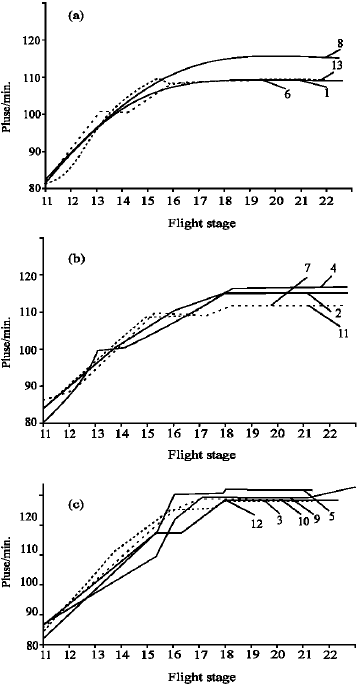ABSTRACT
This paper presents comparative study for the effects of the element failures of the aerodrome light signal complex (ALSC) on pilots` psycho-physiological state. The study includes results of practical experimental fulfilled on the aircraft trainers. The comparison between ALSC failures and aircraft system failures at take-off and landings is considered.
PDF Abstract XML References Citation
How to cite this article
DOI: 10.3923/jas.2004.297.301
URL: https://scialert.net/abstract/?doi=jas.2004.297.301
INTRODUCTION
A great deal of what is written on human factors is written by academics in scholarly journals and rarely receives wide distribution among “working class” pilots. Many of the essays are written for the psychological community in an abstract. In international civil aviation organization (ICAO), the concept of aerodrome light signal complex (ALSC) failure isn’t formulated. These failures affect the pilots’ psycho-physiological state; which is considered to be a big problem that affects flight safety and leads to aircraft accident. When the pilot exposes to such circumstances, adrenalin and blood are concentrated in the limbs and consequently the other parts of the body-especially the brain-are starved of blood. The eyesight, senses and hearing become adversely affected with consequential impairment of thinking process, loss of panel scan, etc. The limbs on the other hand are overly strong with the loss of fitness and over control results. In such circumstances pilots are likely to make mistakes. Such physiological reactions will occur when pilots are faced with direct threat to their survival.
During flying in complicated weather condition (CWC), the pilot may run into situation when he can’t be visually oriented in space relative to the runway or to the ground, which causes false feeling of aircraft attitude, this situation is called “spatial disorientation”. In such case, probability of an inaccurate actions or decision-making is very high specially when it is combined with failure in ALSC or aircraft instrument system.
Statistics shows that 3-4% of the whole number of aircraft taking-off and landings lays in CWC category I and II (ICAO classifications) where 60% of registered crashes take place. So experimental investigations give knowledge of ALSC elements failure and its influence on pilot’s psycho-physiological state and estimate the severity of this influence. These investigations provide appointed level of flight safety by focusing on functional employment of ALSC elements when flying in CWC. Analysis devoted to this problem[1,2] did not consider the influence of ALSC elements failure on pilots’ psycho-physiological state. Pilot landing in CWC with the help of ALSC are analyzed[1], but the main attention was given to study the time distribution between pilot sight on instrument board and outside the cabin when flying in automatic directory conditions, but the influence of ALSC on pilots’ spatial orientation wasn’t analyzed. Royal Aerospace Institute, focuses on ALSC simplification and price reduction[2], special flying experiments have shown the possibility of some simplification of lighting characteristics of ALSC, but in their work, instrumental effect on pilot’s psycho-physiological state wasn’t considered. This paper is devoted to the analysis of the ALSC failures on pilot’s psycho-physiological state in comparison with aircraft systems’ failure.
MATERIALS AND METHODS
Experimental investigations were fulfilled on the trainers of aircraft TU-154 and IL-86 (Russian made). The aircraft commander was chosen and he wasn’t warned about the beginning of ALSC failures. The parameters of psycho-physiological state were determined by frequency of systole (FS), which is the number of heart retraction, FS increased with the severity of the event threats. Estimation of pilot’s psycho-physiological state is considered[3]. The FS limits are as follows:
| • | Optimum (4-16 blows min-1) |
| • | Permissible (17-28 blows min-1) |
| • | Inadmissible (more than 28 blows min-1) |
In the experiments it was impossible to take into account CWC, therefore, failures were chosen which might influence the degree of apprehension of ALSC instead of CWC. Artificial failures leading to partial or whole redeeming of lights of some functional ALSC groups will make the crew unable to determine aircraft attitude with respect to the runway. This may simulate the influence of CWC on light image of ALSC. In the experiment the different types of artificial failures were introduced on ALSC:
| • | Type (1) failure: disordered ALSC but with permissible norms of light failure. |
| • | Type (2) failure: the same as 1 but failures were grouped in subgroup lights. |
| • | Type (3) failure: it simulates failure of one-brightness regulators or break of one cable of different light group. |
| • | Type (4) failure: failure of the whole ALSC or failures of two or more of brightness regulators. |
For a comparative estimation of the influence of ALSC failure and the failure of aircraft board systems on pilot’s psycho-physiological state, the following failures were introduced in the trainer experiments:
| 1. | Unexpected presence of vehicle on runway at take-off and landing. |
| 2. | Failure in the flight at final approach. |
| 3. | Failure of all engines followed by starting one of them. |
| 4. | Adverse wind on height 15-45 m above ground level (AGL). |
| 5. | Failure of automatic control system (ACS). |
| 6. | Scrap in oil of the third engine. |
| 7. | Third engine fire. |
| 8. | Failure of flight path system with overshoot. |
| 9. | Failure of hydraulic system. |
| 10. | Stabilizer drift on height 100-110 m AGL. |
Investigations were carried out on crews who practiced flying in different seasons and after landing they were interrogated if they notice any change of lights of ALSC, what is their opinion about the emergency? And how can they classify influence of the failure on the crew?
Pilot’s FS was measured by electrocardiograph “futon”. The frequency was read by signal from transducers, which were fixed on pilot hands and legs. Speed of the tape in cardiograph was 5 m sec-1. On the tape there is also a mark indicates the beginning and the end of recording, for example, the moment of the entrance into the glide path, passing the decision making height, passing inner and outer homing radio beacons (IHRB and OHRB, respectively), passing the end of runway and others were recorded (Fig. 1). The recording starts by pulling the trigger. Frequency of Systole FS was determined by the formula:
Where ΔL is the distance between two sequential systole pulses on the tape. As the FS differs from pilot to another, the initial pilot conditions were recorded and calculated as below:
 | (1) |
Where xi is FS of the pilot at testing. RMS deviation of FS was defined by:
 | (2) |
During the experiment pilot wasn’t warned about the moment of recording. It was recorded:
| 1. | Forty three final approaches from turning final to end of braking on runway. |
| 2. | Six taxing on the taxiway up to the take-off position. |
| 3. | Nine take-off including 6 interrupted due to appearance of cars on the runway or losing of all ALSC lights at critical speed. |
| 4. | Five recordings of maneuvers including 1 and 2 banks after take-off. |
| 5. | Nineteen recordings for FS of the pilot flying from turning to downwind leg to the base turn. |
| 6. | Five modes of failures in all engines followed by starting one of them then continuing to the final approach with one engine. |
| 7. | Five modes of overshoot from height 15 m (almost flaring) because of disappearance of lights after normal visual contact. |
| 8. | Seven modes of overshoot from height 10 m because of overshooting landing point on the runway at fair or adverse wind. |
| 9. | Four modes of overshoot because of flight path system failure. |
| 10. | Four modes of overshoot because of Automatic Control System failure |
| 11. | Four modes of detecting chips in oil (caution light of the third engine) when flying to the base leg. |
| Table 1: | The investigational results of the pilots (%), which determine the position of failed ALSC lights with accuracy tolerance of 100 m |
 | |
 | |
| Fig. 1: | Overview of the Aerodrome showing the heights and light signals during landing. Where 1,2 = the safety sidebands; 3 = the taxiways used for the motion of the aircraft on the aerodrome; 4 = the system of colored landing lights that enables pilot to be well oriented in the final stage of landing and with it taking off; 5,6 = the intersection of the narrowly-directed zones of emission course and glide-path beacons. OHRB, IHRB are the Outer and inner homing radio beacons. |
| 12. | 4 modes of attitude and direction indicator (ADI) failure after entering the glide path. |
| 13. | 6 events of hydraulic system failure. |
| 14. | 5 events of stabilizer drift at a height of 110 m. |
RESULTS AND DISCUSSION
The analysis of these results shows that frequency of pulse and its regularity were changed in dependence on the stages and conditions of flight (Fig. 3a, b and c). Flying without emergency condition perceptible increasing of FS took place in the moments of take-off and climb. In flat flight (from turn on downwind leg into base leg, when the commander is resting) number of systole was decreased little by little and approximately in 70% recordings, it became lower than the initial number. FS of the pilot in the moment of request for engine starting was taken as initial value. At the time of descent and final approach pilot’s pulse is increased rhythmically, beginning from the moment of beginning of turn to final up to the height of taking a decision. If any of ALSC failures takes place, pilot’s pulse continues to increase up to the time of passing the end of runway and in separate occasions-up to the ending of the leveling.
For relative estimation of FS changing at partial ALSC-failures in the experiment values of pilot’s FS at failures of board systems, which result in special accidents in the flight and pilots’ FS when landing in special conditions were recorded.
For comparative estimation of values of pilots’ FS they were recorded at final approach in automatic and directory modes on the trainer and in real conditions beginning from turn to final up to the moment of landing. Analysis of results of comparative estimation showed their identity.
Part of the results of investigation is given as a histogram and plots of pilots’ FS values on different technological stages of flight (Fig. 2), on final approach and at appearance of failures of board system and ALSC. Stages of flight were divided into 30 intervals; failures of ALSC were introduced after turning to final, from 11 to 22 intervals.
The flight stages: The technological stages on which the experimental investigation were carried out were distributed in the following manner:
| 1. | Taxiing of the plane to line-up take-off position. |
| 2. | reading of preflight map on line-up take-off position. |
| 3. | Running of the plane on the runway for taking off. |
| 4. | Interrupted take-off due to disappearance of lights. |
| 5. | One and 2 banks carrying out. |
| 6. | Crew commander is resting in the interval from turning on downwind leg till the turning to base leg. |
| 7. | Failure all of engines in the flight. |
| 8. | Starting of the first engine in the flight. |
| 9. | Unsuccessful starting of other engines in the flight. |
| 10. | Turning on base leg in normal conditions. |
| 11. | Turning to final. |
| 12. | Entering in glide path. |
| 13. | Passing of outer radio beacon of homing station |
| 14. | Passing of inner radio beacon of homing station. |
| 15. | Height of decision making at meteominimum of category (I) ICAO. (16)-Height of a decision making at meteominimum of category (II) ICAO. |
 | |
| Fig. 2: | Values of pilot’s heart pulsation rate on different flight stages at final approach and at appearance of board system failures |
| 17. | Passing the end of runway. |
| 18. | Leveling of the plane above runway. |
| 19. | Flare-up of the plane above runway. |
| 20. | Landing. |
| 21. | Running of the plane on runway. |
| 22. | Rolling the plane out of the runway at losing of visual contact. |
| 23. | Overshoot from the height 15 m at lights turning off. |
| 24. | Overshoot from the height 10 m at approach with failing to reach the runway or overshooting due to wind drift. |
| 25. | Overshoot due to the trajectory control system failure after entering in glide path. |
| 26. | Overshoot due to automatic control system failure after entering in glide path. |
| 27. | Operation of signaling “Scrap in the oil of 3rd engine” in the region of turn on base leg. |
| 28. | Airport brake cart failure after entering in glade path. |
| 29. | Hydro-system failure in the region of radio beacon closed homing station. |
| 30. | Spontaneous drift of stabilizer at a flight height of 110m. |
Analysis of the results gives the following conclusions:
| 1. | Pilot heart pulsation is simply dependent on failures of ALSC elements; value of FS may be divided into two ranges. First range is characterized by increasing FS as compared to the resting rate (40 …45 pulses min-1 Fig. 3b), this range is considered to be out of the permissible values. Second range is characterized by FS increasing on 27 … 32 pulses min-1 (Fig. 3c), i.e. it’s on the border of permissible and inadmissible values. |
 | |
| Fig. 3: | Pilot’s heart pulsation rate on different technological flight stages at different ALSC failures “type 1,2,3”(a, b); “type 4”(c) |
| 2. | The influence of board systems failures on pilot’s FS is the same as the influence of ALSC elements failure. |
| 3. | The influence of board systems failures (failure of 3rd engines, failure of hydro-system, spontaneous drift of stabilizer and so on), which result in complicated situations of a flight, corresponds to the increasing of pilot’s FS at ALSC failures “type 4”. |
| 4. | The second range pilot’s FS resulted from ALSC failures are closed to board systems failures, which result in complicated flight conditions. These failures can be fixed by the pilots usually and consequently no needs for changing the plan of the flight.. Therefore it may be assumed, that in investigations of influence of ALSC on flights safety well-known methods and models[4], which are used in investigations of influence of board systems failures on level of safety, may be employed. |
| 5. | It may be concluded that ALSC is one of the systems, refusals of which directly influence the psycho-physiological state of pilot and the degree of this influence is analogous to the action of other components of aviation onboard system. For flight safety, the same detailed methods and models[4] for the influences of the onboard system refusals may be used for the study of the ALSC failures on pilot’s psycho-physiological state. |








